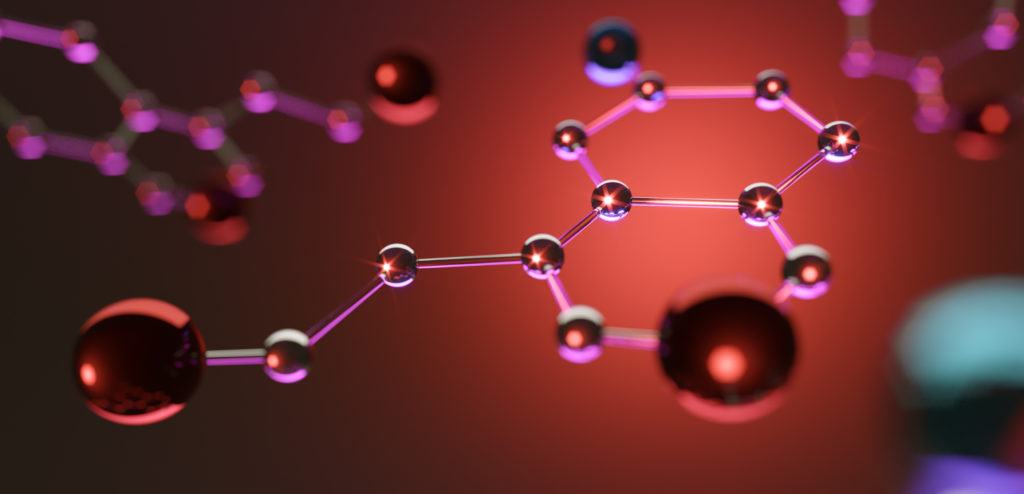
Abundant scientific evidence shows the effects of psychedelic substances like psilocin are mediated via activation of 5-HT2A receptors in the brain,1–6 primarily in the prefrontal cortex.7–9 The abbreviation 5-HT stands for 5-hydroxytryptamine, the chemical name for serotonin. Psilocin (the metabolically active form of psilocybin) is a serotonin agonist. This means it binds to serotonin receptors and produces a physiological effect.
There are seven known classes of the 5-HT receptor with a total of 14 subtypes.10 and psilocin and psilocybin have different affinities for them. When these molecules bind to a receptor, it causes a variety of effects. For example, psilocin binds as an agonist to the 5-HT2A receptor and causes the psychedelic effects magic mushrooms are famous for.
Binding Affinity – The Measure of Separation
Scientists test how well drugs and chemicals bind to receptors by measuring their binding affinity, designated by the symbol Ki. Binding affinity is one kind of dissociation constant. This means that the higher the number, the more likely the substance is to separate from the receptor. Conversely, low binding affinity values mean the substance binds more strongly and is less likely to dissociate from the receptor. These binding affinities are measured in nanomoles (nM). Table 1 shows the binding affinity of psilocin and psilocybin for several 5-HT receptor subtypes.
Table 1: Binding affinities for psilocybin and psilocin at 5-HT receptors.11
| Receptor | Psilocybin Ki (nM) | Psilocin Ki (nM) | Species |
|---|---|---|---|
| 5-HT1A | >10,000 | 49.0 | human |
| 5-HT1B | >10,000 | 219.6 | human |
| 5-HT1D | 2,119 | 36.4 | human |
| 5-HT1E | 194.8 | 52.2 | human |
| 5-HT2A | >10,000 | 107.2 | human |
| 5-HT2B | 98.7 | 4.6 | human |
| 5-HT2C | >10,000 | 97.3 | rat |
| 5-HT3 | >10,000 | >10,000 | human |
| 5-HT5 | 6,181.0 | 83.7 | human |
| 5-HT6 | 413.5 | 57.0 | human |
| 5-HT7 | 597.9 | 3.5 | human |
There are no data available for 5-HT1F, 5-HT4, 5-HT5A, and 5-HT5B.
Why is This Important?
These data clear up the common misconception that psilocybin is the main active ingredient in magic mushrooms. The table shows that for the 5-HT2A receptor (the one responsible for psychedelic/hallucinogenic effects), psilocybin has a Ki of >10,000 nM and psilocin 107.2 nM. The significantly lower dissociation constant for psilocin means it binds more strongly to the receptor and has a greater effect. Also, note the significantly lower binding affinities for psilocin on other serotonin receptors such as 5-HT1A, 5-HT1B, and 5-HT2C. Scientists do not understand (and are not currently studying) how the binding affinities at all these receptors translate into the effects experienced by people who ingest magic mushrooms containing psilocybin and psilocin.

I’m pretty sure it’s 5-hydroxytryptamine, not “-tryptophan”. Tryptophan is an amino acid in foods like turkey that can make you feel tired. Tryptamines describes a group of chemicals which includes serotonin. Small but important difference there.
Yikes. Thanks for pointing out that error, Henry. I made the correction.
But it is part of the tryptophan group correct?
Walker, decarboxylation of tryptophan to tryptamine is the first step in the psilocybin biosynthesis, according to this study – https://www.sciencedirect.com/science/article/pii/B9780444634627000051
Thank you for this. This is great information that everyone should see.
nM stands for nanomolar, wich means nanomol per liter
Does psilocin have a stronger affinity for any receptors than serotonin itself?
I have been trying to find evidence to see if psilocybin produces serotonin. I know that it binds to serotonin receptors and sends specific signals but I want to know if it produces serotonin and if so will itaffect your regular serotonin levels in the brain. If anyone has further information that would be much appreciated .
Josh, it weekly inhibits SERT(5-HT transporter). It’s about 1/3000 the potency of Prozac, but it still raises 5-HT levels somewhat and is also a MAO-A substrate, to some degree, similar to hordenine with mao-b
You might like this too https://pubmed.ncbi.nlm.nih.gov/9387886/
It seems the effect is mediated through D2 agonism, but NMDA blockade could have an impact as well through enhancing LTP